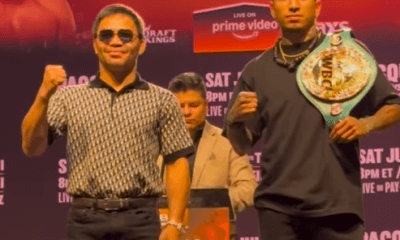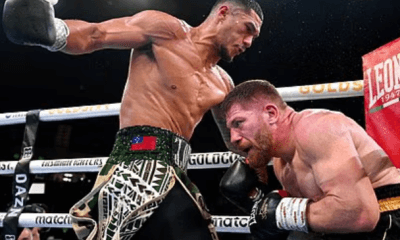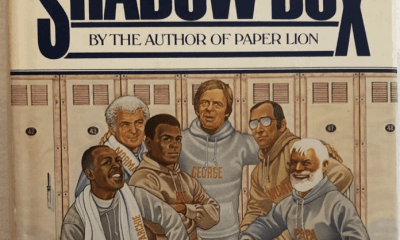Featured Articles
WYLIE OBSERVATIONS: Duane Ford Is Off, Sergio Good Bet Over Chavez
 Here are some thoughts I had after watching the second installment of Jim Lampley's “The Fight Game” on Saturday night.
Here are some thoughts I had after watching the second installment of Jim Lampley's “The Fight Game” on Saturday night.
~ Duane Ford mentioned that the old Pacquiao would have finished Bradley in the 4th round -this is completely irrelevant. This has nothing to do with round scoring. If he went further and said Bradley showed good defense in making Pacquiao miss, then that's reasonable, as defense is one of the judging criteria. However, Ford was clearly speaking of Pacquiao's inability to finish Bradley because he thought Pacquiao had lost a step. This is wrong. However, are we not ALL guilty of this? It is hard to empty ones mind and focus entirely on the visual at hand without reflecting on past events.
Let's say Mayweather in his next fight is taking clean shots with his back to the ropes. How long would an official allow him to absorb clean blows before ending it? My answer would be not as many as the same official would have allowed Gatti to take before deciding that he's had enough. Officials should be thinking of nothing but what is taking place in front of them. But, as we all know, this is not always the case. Gatti would receive the benefit of the doubt because of what he did in past fights.
Back to round scoring. Let's say a fighter is dominating the first seven rounds and I mean dominating. Suddenly, he is not as dominant in the eighth. I guarantee the judges would score that for he other fighter. Now, let's say that the events that took place in the eighth round occurred in the first. Do you think the round would be awarded to the same fighter? I think not. Hence, we have comparative rounds when the criteria is changed from ring generalship, defense, clean punching and effective aggression to “well, he did better in that round so I'm going to give it to him.”
~ HBO did a good thing by showing round seven of the Pacquiao-Bradley fight again. But they failed to show it in the right context. They turned the sound off, which showed it was a close round. They then should have repeated the round with the full commentary and CompuBox graphic which showed Pacquiao apparently landing 27 punches in the round. A similar event took place in the 11th round too. If you have access to round 11, watch it again with the sound off. Pacquiao -according to CompuBox- landed 21 punches in the round. As the round ends, turn on the sound. You will hear Jim Lampley again claim that it was yet another dominant round for Pacquiao. {I thought Bradley dominated the round}. My point is by looking at the 7th and 11th rounds combined, if you can tell me how Pacquiao landed 48 punches then you are a better man than me because you will have done the judging equivalent of walking on water.
At the end of the day, just as many are claiming the judges made a mistake, so too can CompuBox counters, who are men clicking a button everytime they deem a punch has been landed. Humans, not computers, control CompuBox.
In all honesty, I think that episode of Fight Game pretty much summed up the whole situation, but not in the way they intended. HBO, and in particular, Jim Lampley has an infatuation with Manny Pacquiao. It started with the Clottey fight and continues to this day. Along the way I've heard things like “Boom, bang, that's the hardest jab I've ever seen” and Manny Pacquiao, the citizen of the world.”
The mere fact that Lampley held court for 30 minutes on HBO looking for answers when there have been far worse decisions -Lara v Williams and Abril v Rios- speaks volumes. Despite HBO's best efforts, there were no conspiracies. Just a close fight that could have gone either way. I scored it 115-115 even, a draw, with four rounds that could have gone either way.
Again, round seven is as good as any to view again. Without the sound it was a closely contested round, in which I felt Bradley shaded it through workrate. With the full HBO affect, it was a Pacquiao massacre in which, according to the gospel that is CompuBox, Pacquiao landed 27 punches.
The bigger issue in my mind is commentators are becoming narrators for the networks. By painting a picture, they are inadvertently feeding our minds. I remember watching the fight live. The amount of Tweets that were popping up as the fight was happening suggested to me that not everyone was giving their full attention to the fight. Instead, as they were tweeting, they were listening to what was happening.
If this was the radio era, then I agree. By listening to HBO, this would have been the worst decision in boxing history. The reality? This was a close fight that could have gone either way.
If anything, we should be applauding the decision, not condemning it. How many times have close fights ended with the marquee name gaining the decision win? Finally, we have a close fight where the lesser known fighter receives the benefit of the doubt and we cry treason!
Only in boxing!
Also, some thoughts on Julio Cesar Chavez Junior's win over Andy Lee…Junior is gargantuan for the division which, when married with his pressurizing style, makes him nigh on impossible to beat for any middleweight -including Sergio Martinez. In my opinion, one would have to back Chavez up to beat him. His size, ultra-aggression and his ever improving skills are simply too much to contend with on the back foot. As we know, Martinez' style would oblige Chavez by being on the back foot. Chavez would be allowed to fight his usual fight against Martinez. Remember, the last time Martinez tasted true defeat was also to a larger swarming Mexican in Antonio Margarito, who applied constant pressure. Didn't Pavlik's size and forward momentum not also give Sergio problems late in the fight?
Simply put, there is an obvious reason why we have weight divisions. As long as Chavez can healthily make weight and hydrate well over night, he will continue to be a huge obstacle for every smaller opponent he faces. Lee was taller, but essentially, smaller. Martinez -a natural junior middleweight- would have his hands full against someone who could probably make light-heavyweight. I wouldn't be at all surprised if Chavez could even take Martinez' power. THOSE WERE MY INITIAL THOUGHTS…But I rewatched Chavez-Lee. Now I see Chavez being made to order for Martinez. Initially, like everyone else, I was quick to talk of the 'new' Chavez. I still think his size is problematic, but Martinez is a full level and then some above Lee. His stamina is also vastly superior to Lee's. This could look a lot like Pacquiao-Hatton! Chavez -unlike his father- does not move his head.
-

 Featured Articles3 weeks ago
Featured Articles3 weeks agoAvila Perspective, Chap. 330: Matchroom in New York plus the Latest on Canelo-Crawford
-

 Featured Articles2 weeks ago
Featured Articles2 weeks agoVito Mielnicki Jr Whitewashes Kamil Gardzielik Before the Home Folks in Newark
-

 Featured Articles4 weeks ago
Featured Articles4 weeks agoAvila Perspective, Chap 329: Pacquiao is Back, Fabio in England and More
-

 Featured Articles3 weeks ago
Featured Articles3 weeks agoOpetaia and Nakatani Crush Overmatched Foes, Capping Off a Wild Boxing Weekend
-

 Featured Articles2 weeks ago
Featured Articles2 weeks agoCatching Up with Clay Moyle Who Talks About His Massive Collection of Boxing Books
-

 Featured Articles4 weeks ago
Featured Articles4 weeks agoFabio Wardley Comes from Behind to KO Justis Huni
-

 Featured Articles1 week ago
Featured Articles1 week agoMore Medals for Hawaii’s Patricio Family at the USA Boxing Summer Festival
-

 Featured Articles4 weeks ago
Featured Articles4 weeks agoDelving into ‘Hoopla’ with Notes on Books by George Plimpton and Joyce Carol Oates















